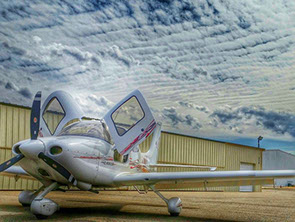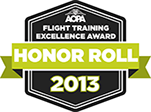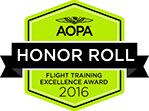Should you train at a Part 141 or Part 61 flight school?
This is not a simple question, however this should help you find the obvious answer.
The part numbers refer to the applicable regulations, 14 CFR 61 and 14 CFR 141. A flight school has the option of teaching under either part. Part 61 is the simpler system. On the surface it appears to require more hours, but its flexibility far outweighs this. Part 141 gives the school the opportunity to graduate students with fewer hours, but it places more restrictions on the training.
No matter which route you choose, your pilot’s certificate is the same when you have completed the course. The FAA expects the same performance standards in order to award a certificate or rating.
The FAA is required to oversee the operations of a part 141 school to a much higher degree. All the records are reviewed on a regular basis for compliance and completeness. This significantly increases the workload for the school. You will rarely find a part 141 school with lower prices than a part 61 school because of this.
A part 141 and part 61 school often use the same syllabus. The 141 school is required to use that syllabus precisely. There is very little variation allowed, which is fine if all students are the same, but of course they are not. A part 61 program will most likely use the same syllabus, but the instructor will be allowed flexibility to meet the needs of each student.
Just being part 61 or 141 does not automatically indicate the quality of a school. As there are many part 61 schools that do an outstanding job in educating student pilots, there are also those that use the flexibility to just do enough to get by. You can usually identify these schools by their pass rates and reputations amongst the local pilot community.
A 141 school may emphasize the fact that their private pilot program only requires 35 hours of flight training, while a 61 program requires 40. That sounds great until you consider that the national average is 60 – 75 hours to obtain a private pilot certificate. It is extremely rare to see a student ready for a checkride in less than 40 hours.
For a career path, the 141 school will say that it is possible to get a commercial certificate in 190 hours of flight training. Technically this is true, but only if all the hours are flown in the schools approved aircraft, all ratings are attained in the minimum hours, every flight follows a pre-approved syllabus (regarding exactly where each flight is flown and who is onboard), and you can forget taking a trip for fun. A 141 program will require 55 hours of dual instruction, and 65 of solo flight. No passengers allowed, solo means solo and the syllabus must be followed.
If you want to transfer schools be prepared to pay a penalty in hours that can be credited to you. A 141 school can only give you credit for 25% of the hours you earn outside of a 141 program, and will only give you credit for 50% of the allowable hours you trained for at a 141 school.
At a part 61 school, you will need 250 hours total flight time in order to take the checkride for commercial pilot. Fifty of these hours can be obtained in a flight training device (simulator). These hours can be obtained in many ways, which most often will give the part 61 student the most variety in aviation. Want a glider rating, or want to get checked out in another aircraft such as a Cirrus or a gyroplane? Those hours will count towards your commercial ticket, and you be a much more well-rounded pilot than your part 141 counterpart. You can even begin to train for your instructor rating while gaining those 250 hours. The part 141 student will have to spend 120 hours working through their syllabus, no fun trips, no passengers, only visiting approved airports.
Those students with GI Bill benefits will most likely be able to use them to pay for 60% of their flight training after they have attained the private pilot certificate, and only part 141 schools can have this program. The understated restriction here however is that a school can only have 85% of their students enrolled in the GI Bill program. So what does a part 141 school do to boost up the other 15%? They convince their other students to enroll in the 141 program.
How about that instrument rating? Part 141 schools tell their customers that the real benefit to the program is that there is no requirement of 50 hours of cross country PIC time prior to taking the instrument checkride. This is true. A brand new pilot can immediately begin their instrument training without gaining that cross country flight experience. But here’s the deal: most pilots who want to go straight into an instrument rating are career bound pilots, and therefore will need those hours anyhow. My suggestion is to get these hours with a safety pilot, flying cross country flights under the hood to a wide variety of airports. That way both pilots can log PIC time, and you will get an amazing amount of practical experience that will benefit you in so many ways. Split the cost with your safety pilot and save a lot of money too.
So now that you have spent 30 – 40 hours flying your cross country flights under the hood with your safety pilot, let me show you another benefit; those hours will count towards your hood time for your IFR rating too, but only in a part 61 program. Under part 141 you are required to get 35 hours of hood time while completing the syllabus. If you just compare that to the 40 hour requirement of part 61 it’s easy to think that 141 is better. However, even though part 61 requires 40 hours of hood time, only 15 have to be with an instructor. The rest can be obtained with a safety pilot. Not only that, the 3 hours you got during your private training will also count towards the 40 hours. Not so in a 141 program.
Still having doubts about the IFR program under part 61? Let’s talk simulators. Sims are amazingly beneficial when it comes to instrument training. I would estimate that an instrument student will make twice the progress in an hour of sim flight compared to an hour of time in the aircraft, at about 2/3rds the price. So how much flight training device time can be applied in each program? Part 61 allows for a 20 hour credit, while 141 only allows 14 hours.
How do the instructors compare? If you train at a 141 school your CFI will most likely be one that just completed the same program you are going through. These instructors typically have a much lower number of hours each and a narrower experience level. There’s a good chance that they have only flown two or three types of aircraft in their limited experience. This does not necessarily make them bad instructors, just not as experienced.
Who benefits from a part 141 course? Only foreign students or those wishing to use their GI Bill benefits. Foreign students in the US for the purpose of flight training must go to a school that is in the SEVIS program, and that is only available for part 141 schools.
While the additional record keeping, approved training syllabi, and other FAA oversight over a Part 141 school provides a certain level of consistency, a savvy student can learn a lot about a Part 61 school by asking a few simple questions:
1. Does the school use a syllabus? Without a syllabus, the student won’t know what to prepare for on each lesson.
2. Are flight training devices used to supplement aircraft time? A student’s learning experience is greatly enhanced with the use of a simulator.
3. Are the instructors a mix of experience levels? If all the instructors at a school were trained at that school, they will probably lack real world experience.
4. How is aircraft maintenance handled? Is the school ready to handle maintenance issues as needed?
5. What is the average time and cost for completion? Not only in hours, but in months.
6. Does the school use multiple pilot examiners? Using just one pilot examiner to administer end-of-course checkrides may indicate that students are only being trained well enough to pass that particular examiner’s test. Students should be trained and confident enough to pass with any examiner.
At Glass Cockpit Aviation in this past year we have produced more pilots and ratings with a higher pass rate than the other Boise schools combined. We utilize the most advanced aircraft and simulators, and employ the best instructors in the business. To top it off, even with all this flight activity, our safety record is the best in Boise.
So before you are convinced by a part 141 rep that their program is the best, consider these issues. Ask the right questions and don’t be misled down the minimum hours rabbit trail.
AutoGyro GmbH
Sales, Service, &
Flight Training

Independent
Repair
Maintenance
Technician

Boise Airport -3815 Rickenbacker St #203 - Boise - Idaho - 83705 - Tel: 208-869-6459 - SMS: 208-807-0582 - info@glasscockpitaviation.com



